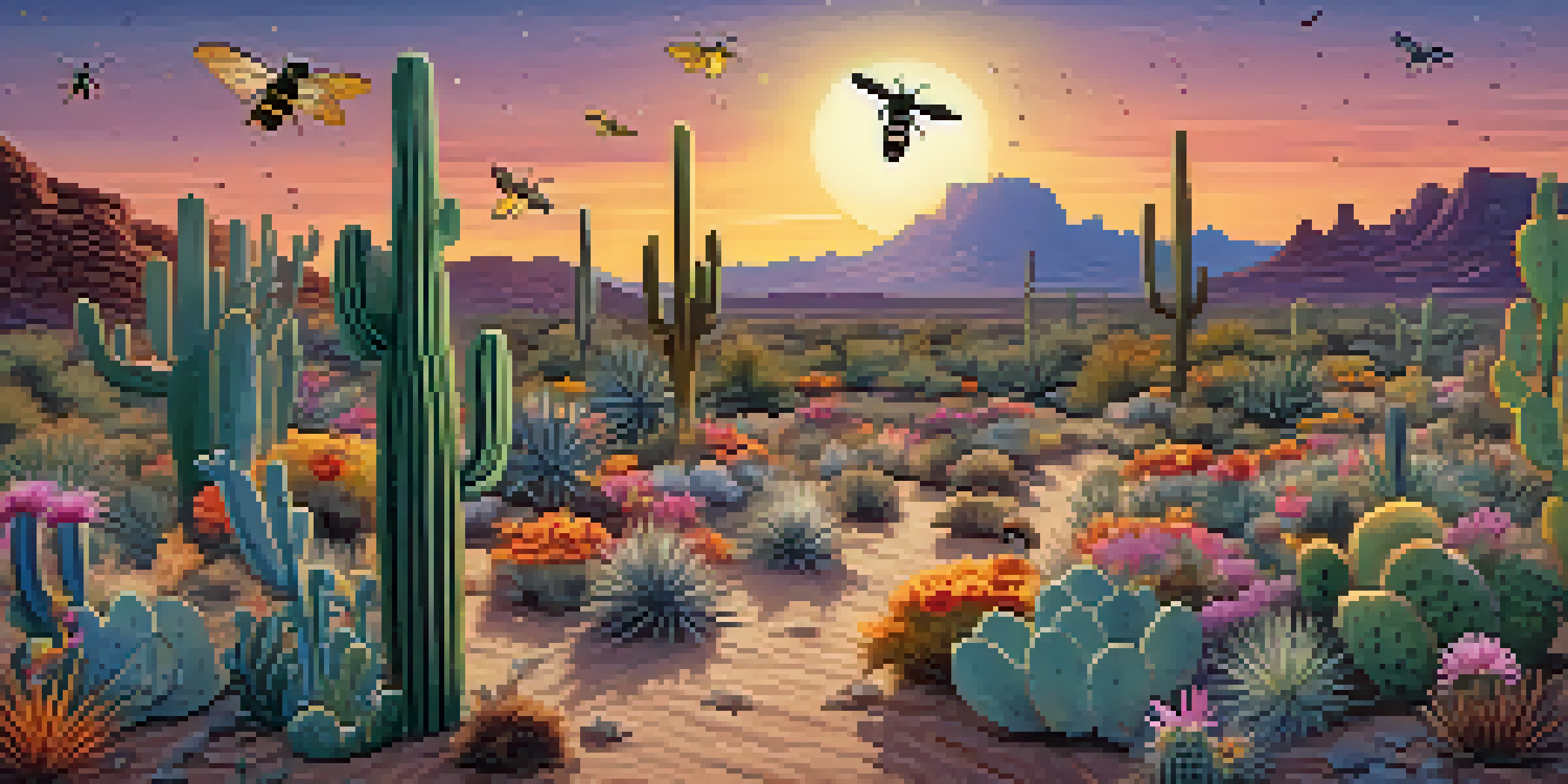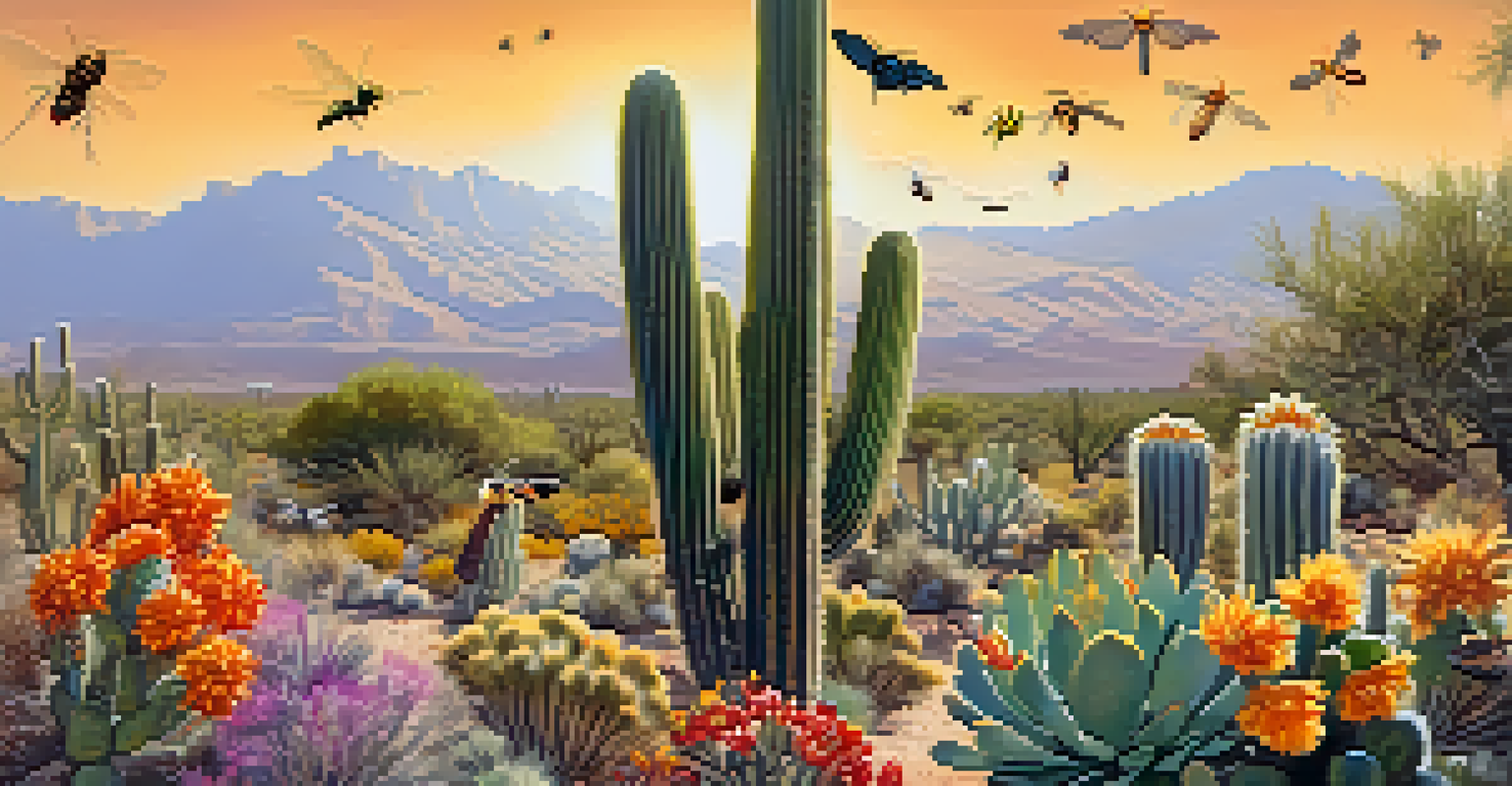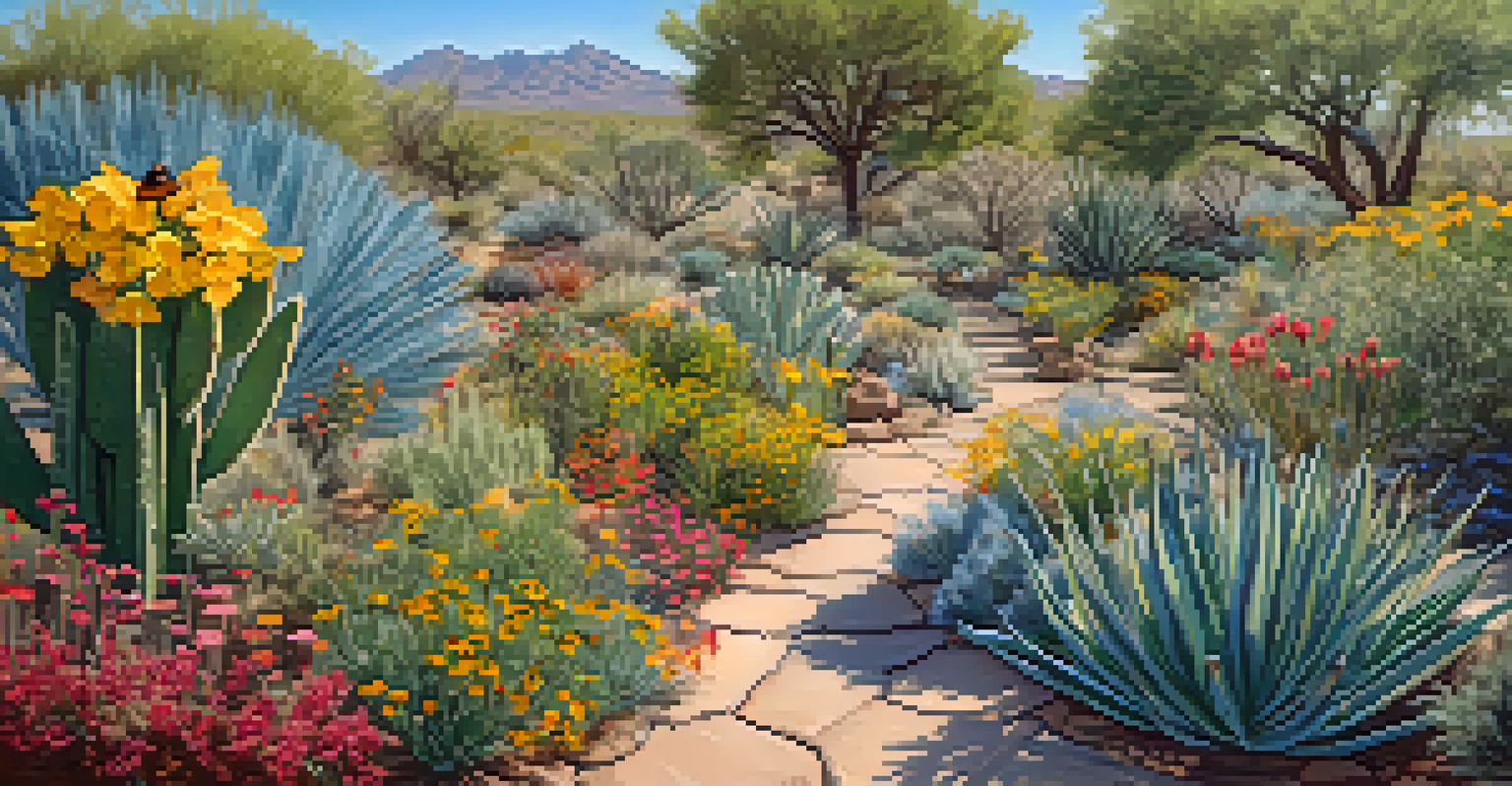The Role of Pollinators in the Sonoran Desert Ecosystem

Understanding Pollinators in the Sonoran Desert
Pollinators are vital players in the ecosystem, responsible for facilitating the reproduction of many plant species. In the Sonoran Desert, these creatures include bees, butterflies, bats, and even some birds. Each of these pollinators plays a unique role in ensuring that flowering plants can produce seeds and fruits, which are crucial for sustaining wildlife.
The hum of bees is the sound of the heartbeat of the earth.
The harsh conditions of the Sonoran Desert, marked by extreme temperatures and arid landscapes, make the role of pollinators even more significant. Without them, many plants would struggle to reproduce, leading to a cascade of effects throughout the ecosystem. It's fascinating how such small creatures can have such a profound impact on their environment.
Pollinators not only support plant life but also contribute to the overall health of the ecosystem. By enabling plant reproduction, they help maintain the food web that supports various animals, including larger species that rely on these plants for nutrition.
The Diversity of Pollinators in the Desert
The Sonoran Desert is home to a diverse array of pollinators, each adapted to thrive in this unique environment. Among the most notable are the native bee species, which play a crucial role in pollinating cacti and other desert plants. These bees have evolved to navigate the harsh conditions and find food sources that are sparse in this arid landscape.

Bats also contribute significantly to pollination, especially during the night when many desert flowers bloom. Some species, like the lesser long-nosed bat, have a diet that primarily consists of nectar, making them essential for the reproduction of certain plants. This nocturnal activity showcases the importance of biodiversity in pollination efforts.
Pollinators Are Vital to Ecosystems
Pollinators facilitate plant reproduction, which is essential for sustaining wildlife in the Sonoran Desert.
Additionally, butterflies and hummingbirds bring their own flair to the pollination process. Their vibrant colors and rapid movements not only attract attention but also help spread pollen among various plants, ensuring genetic diversity. This variety of pollinators illustrates the interconnectedness of life in the Sonoran Desert.
The Relationship Between Pollinators and Plants
The bond between pollinators and plants is one of nature's most remarkable partnerships. Plants have evolved specific traits, such as bright colors and sweet scents, to attract these essential creatures. In turn, pollinators rely on the nectar and pollen from these plants for nourishment, creating a mutually beneficial relationship.
Pollinators are the essential link between plants and the food we eat.
In the Sonoran Desert, many plants, like the saguaro cactus and agave, depend heavily on specific pollinators for their survival. Without these interactions, the ability of these plants to thrive and reproduce would be significantly diminished. This relationship showcases the delicate balance of the desert ecosystem.
Furthermore, the loss of pollinators due to habitat destruction or climate change can have dire consequences for plant populations. A decline in these vital species can lead to reduced plant diversity, which in turn affects all organisms that depend on those plants for food and shelter.
The Impact of Climate Change on Pollinators
Climate change poses a significant threat to the delicate balance of the Sonoran Desert ecosystem. Rising temperatures and changing precipitation patterns can disrupt the timing of flowering plants and the activity of pollinators. This mismatch can lead to decreased pollination success and, ultimately, reduced plant reproduction.
For instance, if plants bloom earlier due to warmer temperatures, but pollinators remain inactive or emerge later, this can result in fewer flowers being pollinated. The repercussions extend beyond individual plant species; entire food webs can be altered, affecting numerous animals reliant on those plants.
Climate Change Threatens Pollinators
Rising temperatures and changing weather patterns disrupt the timing of flowering plants and pollinator activity, jeopardizing ecosystem balance.
Moreover, habitat loss driven by climate change further exacerbates the challenges faced by pollinators. As their natural environments shrink or are altered, pollinator populations may decline, leading to a vicious cycle that threatens the stability of the Sonoran Desert ecosystem.
Human Impacts on Pollinator Populations
Human activities have a profound impact on pollinator populations in the Sonoran Desert. Urban development, agriculture, and pesticide use can lead to habitat loss and fragmentation, making it difficult for pollinators to find food and nesting sites. These changes can drastically reduce the number of pollinators in an area, disrupting the balance of the ecosystem.
Additionally, the use of pesticides can have harmful effects on pollinator health. Chemicals intended to control pests can also harm beneficial insects, leading to a decline in their populations. This reduction can hinder the pollination process, affecting plant survival and the overall health of the ecosystem.
Education and awareness about the importance of pollinators are essential steps in mitigating these impacts. By promoting practices that protect pollinator habitats and reduce pesticide use, we can help sustain these vital species and ensure the continued health of the Sonoran Desert ecosystem.
Conservation Efforts for Pollinators
Conservation efforts are crucial for safeguarding pollinators in the Sonoran Desert. Various organizations and local communities are working together to establish protected areas and restore habitats that support pollinator populations. These initiatives aim to create a more resilient ecosystem that can withstand the pressures of climate change and human activities.
In addition to habitat restoration, educational programs play a vital role in raising awareness about the importance of pollinators. By teaching communities about the benefits of pollinators and how to support them, we can foster a culture of conservation that encourages sustainable practices.
Conservation Efforts Are Crucial
Community-driven conservation initiatives and education are necessary to protect pollinators and their habitats in the Sonoran Desert.
Efforts to create pollinator gardens and promote native plant species are also gaining traction. These gardens provide essential resources for pollinators while enhancing biodiversity. Such initiatives not only benefit pollinators but also enrich the local environment, creating vibrant ecosystems that thrive.
The Future of Pollinators in the Sonoran Desert
The future of pollinators in the Sonoran Desert hinges on our collective actions today. By prioritizing conservation and adopting sustainable practices, we can help ensure that these vital species continue to thrive in their natural habitats. Protecting pollinators is not just about saving individual species; it's about preserving the intricate web of life that supports our ecosystems.
As we face challenges like climate change and habitat degradation, innovative solutions will be key. Research and technology can help us understand pollinator behaviors and needs better, guiding effective conservation strategies. Collaborating with researchers, local communities, and policymakers will be essential in crafting a resilient future for pollinators.

Ultimately, the health of the Sonoran Desert ecosystem relies on the well-being of its pollinators. By recognizing their importance and taking action, we can contribute to a vibrant and sustainable environment for generations to come.